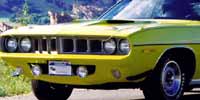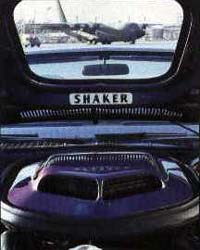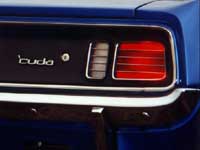The Plymouth Barracuda of 1971 :
Back in 1971 Changes made to the Barracuda for 1971 were mostly cosmetic.
A full range of engines were available and the top
performance models were once again called 'Cudas. The few big changes
that were made on the engines was that the 440-4 bbl was dropped from
the lineup. The 440-6 dropped its compression ratio and lost 5 horses.
The 383 dropped 35 horses, to 300. The AAR 'Cuda was no longer available.
To deal with increasingly strict emission laws, Plymouth was forced
to detune some of their engines, resulting in a drop in the power
ratings. Only 115 Hemi 'Cudas were sold and for 1972, Plymouth decided
to retire the Hemi engine before it had to be detuned to meet the
new emission standards.
But the big changes were aesthetic. The front grille
and valence were completely different. A big grid now housed twice
as many headlights replaced the open mouth grille from '70, and six
scalloped openings. The turn signals moved to the valence. The road
lamps were now optional.
Left over chin spoilers from the AARs were available in '71. On the
other end, the tail lights were modified. In '70, the back-up and
brake lights were a single piece. For '71 they were separated. The
rear spoiler was also changed, but remaining stock from '70 was used
up first.
Four gills were added to the upper rear portion of each fender. Inside,
the seats were completely changed, but not improved, as they now offered
no lateral support whatsoever.
The colors changed as well as the stripe. The hockey stick stripe
was replaced by the "billboard stripe". This stripe, available
in either black or white, covered almost the entire rear quarter.
On the door, the engine displacement, or the word "HEMI",
was called out. Initially, the billboard stripe was a joke created
by a disgruntled employee who was upset that he had been assigned
to a job, stripe design, not worthy of his talents. In a move meant
to anger his boss, this person said to him self, "if you want
a stripe I'll give you a stripe!" He then proceeded to cover
the entire quarter panel, and brought the boss in to prove his point.
Unbelievably, the boss thought it was great and approved it for production!
Sales for the 1971 'cudas dropped to less than 6,000 units. This
was mostly due to the muscle car era coming to a close.




























